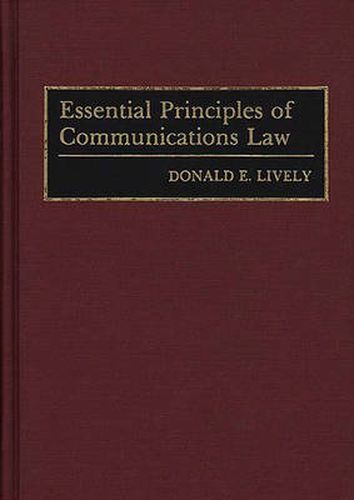Readings Newsletter
Become a Readings Member to make your shopping experience even easier.
Sign in or sign up for free!
You’re not far away from qualifying for FREE standard shipping within Australia
You’ve qualified for FREE standard shipping within Australia
The cart is loading…






Rapid changes in communications technology continue to characterize the industry and to necessitate repeated redefinition of the legal structures and issues which must respond to these changes. Donald E. Lively’s in-depth study of communications law clarifies its basic concepts and principles. He provides a thorough survey of the press as it was originally perceived by the Constitution and how its profile has changed due to the sophisticated nature of today’s media. The book shows how broadcasting, cable, and common carriage disperse a wide range of information - requiring continual monitoring to preserve the balance between responsibility and freedom of the press. This complex issue is first studied from a broad conceptual perspective that reviews the original constitutional and non-constitutional concerns of the first amendment, followed by an analysis of how the structures of the newspaper, broadcasting, cable and common carrier industries have been regulated, and concludes with a history and evaluation of the guidelines which restrict the quantity and quality of content. The identification of trends in the ownership of 20th century information sources and the effect of the current decentralization of ownership on the public’s access to information are fully examined, and the law’s continually evolving attention to the changing dynamics within the industry evaluated for the present and projected for the future.
$9.00 standard shipping within Australia
FREE standard shipping within Australia for orders over $100.00
Express & International shipping calculated at checkout
Rapid changes in communications technology continue to characterize the industry and to necessitate repeated redefinition of the legal structures and issues which must respond to these changes. Donald E. Lively’s in-depth study of communications law clarifies its basic concepts and principles. He provides a thorough survey of the press as it was originally perceived by the Constitution and how its profile has changed due to the sophisticated nature of today’s media. The book shows how broadcasting, cable, and common carriage disperse a wide range of information - requiring continual monitoring to preserve the balance between responsibility and freedom of the press. This complex issue is first studied from a broad conceptual perspective that reviews the original constitutional and non-constitutional concerns of the first amendment, followed by an analysis of how the structures of the newspaper, broadcasting, cable and common carrier industries have been regulated, and concludes with a history and evaluation of the guidelines which restrict the quantity and quality of content. The identification of trends in the ownership of 20th century information sources and the effect of the current decentralization of ownership on the public’s access to information are fully examined, and the law’s continually evolving attention to the changing dynamics within the industry evaluated for the present and projected for the future.